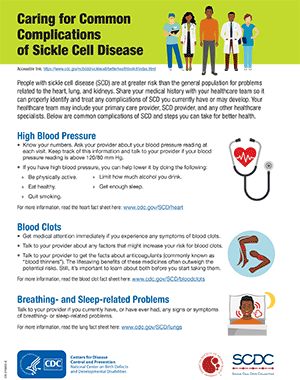NBCI National Sickle Cell Project
Sickle Cell Treatments and Management
Fact Sheets

Healthy Living with Sickle Cell Disease
Living with sickle cell disease can be a challenge. But there are steps you can take to live the healthiest life possible. Follow the link to the CDC Sickle Cell Disease site for articles, materials and multimedia and more fact sheets below to get started. cdc.gov/ncbddd/sicklecell/healthyliving.htmlVideo
Thea: Transitioning Her Son to Adult Sickle Cell Care
Thea is a mother and sickle cell caregiver for her son, Julian, who has sickle cell disease. Thea walks through the ways in which she helped him prepare for this transition throughout his senior year of high school.
Thea is always there for Julian, especially when it comes to his sickle cell disease, but she has also worked hard to help him feel empowered to manage his own care.
Pain Management
The severity of pain caused by sickle cell can range from no pain to mild pain to severe pain. Likewise, the methods to relieve pain also can be different. Here are some good general rules to follow:
- Talk with your healthcare provider
Discuss your symptoms and create a plan to help relieve your pain. This may include medicine and other relief methods, including heating pads or physical therapy. - Use pain medicines thoughtfully
Talk with your healthcare provider about which over-the-counter or prescription medicines are best for you. Some medicines may have side effects. - Look for pain triggers
Every time you’re in sudden pain, try to figure out what may have caused it. Although it may not be obvious at first, keeping a log over time can help you identify triggers. - Find what works for you
No one pain relief method works for everybody. You may have to try different things, such as a warm bath, massage, or acupuncture. Also, do the things that help you relax, like listening to music or hanging out with friends. Reducing stress can also help reduce your pain.
Managing Pain Without Medication
You might find that you can get pain relief with options other than medicines. It is important to discuss all pain management approaches with your healthcare provider to figure out what is best for you.
Physical approaches
- Hydration
- Heat
- Massage
- Acupuncture/acupressure
- Blood transfusions
- Physical therapy
- Transcutaneous electrical nerve stimulation
Psychological approaches
- Distraction
- Imagery
- Hypnotherapy
- Psychotherapy
Behavioral approaches
- Deep breathing
- Relaxation
- Meditation or yoga
- Self-hypnosis
- Biofeedback
- Behavior modification
Please Give to the NBCI $5 Campaign for 2023-2024
Our goal is $250,000. Please make a small contribution of only $5.00, so that the National Black Church Initiative may continue our exciting programs and initiatives!



